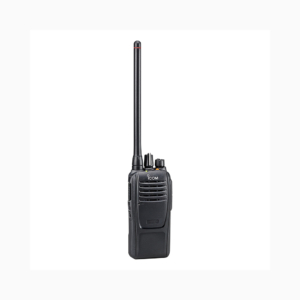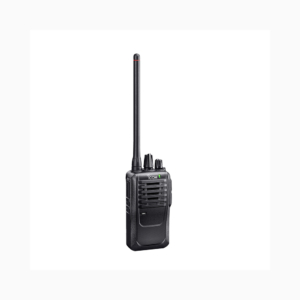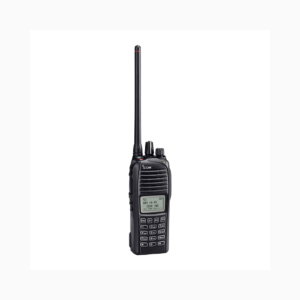UHF Handheld Radios Sets
Ultra High Frequency (UHF) handheld radios, also known as walkie-talkies, are 2-way transceivers that emit shorter wavelengths and more powerful frequencies (136 – 174 MHz) that can easily travel a distance of up to 5 km, depending on the terrain.
For a relatively large marine vessel, like a cargo ship or tanker, it is important to have a reliable internal communication system where the captain is able to communicate with the crew and vice versa. A UHF radio set is ideal because it will not interfere with the existing marine VHF frequencies used and, at the same time, allow communication privacy if required. At Tecomart, we offer handheld radio sets for sale from reputable global brands such as Motorola and ICOM.
UHF Handheld Radio Applications in Marine Communication
Ultra High Frequency (UHF) handheld radios operate in the frequency range of 300 MHz to 3 GHz and are popularly used in many communication scenarios. In marine environments, where reliable communication is paramount, these radios play several crucial roles:
1. Ship-to-Shore Communication
UHF handheld radios in marine applications offer a practical solution for ship-to-shore communication due to their ability to provide clear and consistent signals over short to medium distances.
- Port Operations: When vessels approach ports, communication between the ship and port authorities or ground personnel is essential for smooth docking, offloading, and onloading operations. UHF handheld radios facilitate this exchange of information, helping guide vessels safely into harbours.
- Customs and Immigration: UHF handheld radios allow vessels to establish initial contact with customs and immigration officials, ensuring that procedures are started promptly and correctly.
2. Crew Communication
Communication between crew members on board a vessel is essential for daily operations and safety.
- Deck Operations: Daily tasks like loading, unloading, or even routine maintenance require seamless communication among the crew. UHF handheld radios enable the crew to coordinate these tasks effectively.
- Below Deck and On-Deck Communication: UHF handheld radios are particularly effective in penetrating the ship’s structure, allowing for clear communication between crew members located below deck and those on the deck.
3. Emergency Procedures
In emergency situations, swift and clear communication can make the difference between life and death.
- Man Overboard: In situations where a crew member falls overboard, quick communication using UHF handheld radios can mobilise the necessary personnel and equipment for a rescue operation.
- Fire or Flooding: In case of emergencies like fire or flooding, the crew can use UHF handheld radios to coordinate evacuation, firefighting, or damage control measures.
- Medical Emergencies: If a crew member needs urgent medical attention, UHF handheld radios can be used to contact the ship’s medical team or even communicate with medical professionals onshore.
4. Coordination with Other Vessels
In busy waterways, coordinating movements with other vessels is crucial to avoid collisions and navigate safely.
- Passing Procedures: When two vessels approach each other, they may need to communicate to establish passing intentions. UHF handheld radios allow skippers and pilots of both vessels to talk directly, ensuring safe passage.
- Group Activities: For vessels travelling in a convoy or participating in joint activities (like fishing fleets or research missions), UHF handheld radios facilitate communication among them.
Components of Handheld UHF Analog / Digital Radios Sets
- Antenna: Transmits and receives radio signals to and from the handheld radio set.
- Microphone: Allows the user to transmit audio through the handheld radio set.
- Speaker: Enables the user to hear audio received by the handheld radio set.
- Keypad: Used for dialling in frequencies, adjusting settings, and making other inputs.
- Display Screen: Shows information such as channel, battery status, and signal strength.
- Belt Clip: Attaches the handheld radio set to the user’s belt for easy access.
- Earpiece: Provides private listening for the user.
- Programming Cable: Used to programme the handheld radio set with specific frequencies and settings.
Finding the Right Handheld UHF Analog / Digital Radios Set
Whether you’re a seasoned mariner or just getting started, it’s important to choose the right UHF handheld radio set for your needs. Consider the following:
1. Power
A general rule of thumb is that for every 1 watt of power, there is 1 mile of coverage. The higher the range, the higher the wattage needed. It is recommended to get a higher-powered UHF handheld radio like the APX4500 Single-Band P25 Mobile Radio – Enhanced. With its level of power that provides a strong and reliable signal for clear communication over a wide area, it clears obstructions and harsh weather conditions at sea that will lower the amount of coverage.
2. Waterproof
If you’re planning to use your UHF handheld radio set out on the deck, it is important to choose a waterproof walkie talkie so you will always have clear communications, even during wet and windy conditions. Look for IP-rated UHF radio sets, such as the ICOM IC-F4003 or the Motorola XiR P3688. The first digit of the IP rating represents dust protection, while the second digit represents waterproofing. Higher numbers represent better protection in both cases.
3. Channels
A multi-channel UHF handheld radio system is a great way to improve communication on your marine vessel. By having multiple channels available, like the IC-F4230DS, which has up to 128 memory channels with 8 zones, you can ensure that everyone has the ability to communicate effectively without interference. A multi-channel walkie-talkie system can also ensure that all communications will be kept confidential, providing enhanced security for your vessel.
4. Battery life
A longer battery life means longer talk time and a handheld radio set such as the IC-F4003 helps you stay connected to your crew and other vessels in times of need. In addition, the long battery life of the IC-F4003 makes it suitable for extended use in a variety of applications, such as outdoor recreation, construction, and security.
Get Your Handheld UHF Analog / Digital Radios Sets
Whether you are the captain of a large boat or operate a smaller watercraft, having a dependable communication device is essential. Our UHF handheld radio sets are backed by years of experience and expertise, so you can trust us to provide you with the best possible products and services. With our commitment to quality and customer satisfaction, you can trust that our UHF handheld radios will provide you with the best possible performance and reliability. Other than land mobile radios such as Handheld UHF Analog / Digital Radios Sets and Handheld Analog / Digital Mobile Radios, we also provide other types of marine communication and marine navigation equipment such as AIS transponders and loud hailers at wholesale prices.
At Tecomart, our commitment goes beyond just selling UHF handheld radios. Founded in 1994, we have grown from introducing radio communication equipment in remote regions of Thailand and Indonesia to becoming a beacon of trust in marine communication and navigation. Our hands-on experience with seafarers and fishermen has deepened our understanding of maritime communication challenges. Leveraging this knowledge, along with advancements in GPS technology, we’ve equipped vessels with cutting-edge communication and navigation systems.
Contact us today to learn more about our products and services in the marine industry.
Frequently Asked Questions About UHF Handheld Radios
Showing 1–15 of 35 results
-

IC-F2100D UHF DIGITAL TRANSCEIVER
Request a quote for latest pricing
Request A Quote -

IC-F2100DS UHF DIGITAL TRANSCEIVER
Request a quote for latest pricing
Request A Quote -

IC-F2100DT UHF DIGITAL TRANSCEIVER
Request a quote for latest pricing
Request A Quote -

IC-F4003 UHF TRANSCEIVER
$275.00
Add to cart -

IC-F4230DS UHF TRANSCEIVER
Request a quote for latest pricing
Request A Quote -

IC-F4230DT UHF TRANSCEIVER
Request a quote for latest pricing
Request A Quote -

IC-F4263DS UHF DIGITAL TRANSCEIVERS
Request a quote for latest pricing
Request A Quote -

IC-F4263DT UHF DIGITAL TRANSCEIVER
Request a quote for latest pricing
Request A Quote -

IC-F61 ATEX
Request a quote for latest pricing
Request A Quote -

IC-F62D UHF Digital Transceiver
Request a quote for latest pricing
Request A Quote -

IC-F7020S UHF P25 DIGITAL TRANSCEIVERS
Request a quote for latest pricing
Request A Quote -

IC-F7020T UHF P25 DIGITAL TRANSCEIVERS
Request a quote for latest pricing
Request A Quote -

IC-F7040S 700/800 MHz P25 DIGITAL TRANSCEIVER
Request a quote for latest pricing
Request A Quote -

IC-F7040T 700/800 MHz P25 DIGITAL TRANSCEIVERS
Request a quote for latest pricing
Request A Quote -

IC-F9021B UHF P25 CONVENTIONAL & TRUNKED TRANSCEIVER
Request a quote for latest pricing
Request A Quote
